Tree Fungus is a common ailment for trees. When fungal spores come in contact with a susceptible host they begin to grow, enter, and feed on the tree or shrub.
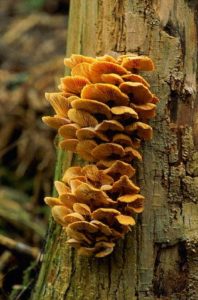
Not all fungi growing on your tree are harmful; some do not affect the tree at all while others are even beneficial. It’s best to have an arborist diagnose what type of fungus is growing on your tree. The arborist will be able to let you know if the fungus is harmful and be able to recommend appropriate treatments.
How A Tree Fungus Spreads:
Tree fungi produce spores that spread and infect other trees or shrubs.
Spores spread through:
- the air on windy days
- hard rains that splash the spores up onto trunks and leaves
- gardening tools
- Human movement; for example, walking through wet diseases plants then walking through healthy plants that aren’t yet infected.
Signs Of A Fungal Disease:
You may see mushrooms or other types of fungi growing on or around your tree if you have a fungal disease. However; many times the tree fungus may not appear above ground or many have a different appearance than you would expect.
The symptoms you see will depend on what type of tree fungus is attacking your tree. In most cases being infected with a tree fungus will result in loss of vigor and discoloration or wilting of leaves.
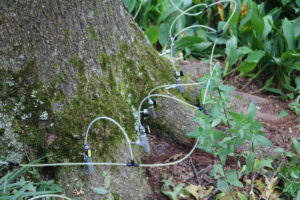 Tree Fungus Treatments:
Tree Fungus Treatments:
Once infected with a tree fungus your tree or shrub can never be fully cured. However; it can be treated. Our arborist will recommend a plan to suppress the tree fungus. This will stop the disease from getting worse and to restore your tree’s health and vigor.
If the fungus is too far developed, the arborist may recommend removing the tree/shrub and replacing it with a fungi resistant species.
Prevention is key when it comes to fungus.
To prevent infection:
- Don’t over water
- Make sure your soil drains properly
- Boost overall health with proper maintenance
- Sanitize gardening tools between plants
- Rake and remove falling leaves from your yard
- Use preventative fungicides
Need Help With A Tree Fungus?
Or Call 703.573.3029 To Book An Appointment Via Phone
Common Tree Fungi
Diseases caused by a tree fungus are separated into four categories, root and butt rot, canker, foliar/shoot, and wilts.
Root Rot Diseases:
Root rot diseases are caused by fungi that are found in the soil and attack the roots of plants.
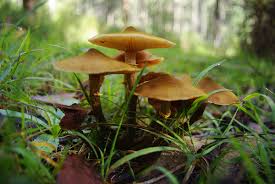 Armillaria Root Rot:
Armillaria Root Rot:
Also known as Oak root fungus, is a disease caused by the fungi of the genus Armillaria. If left untreated it will cause rapid decline and death. In the worst cases, when left untreated trees can become structurally unsafe and uproot or snap possibly causing property damage and injury.
Symptoms: Dulling of leaf color, loss of vigor, leaves turn yellow or brown, leaves wilt.
Targets: This tree fungus has an extremely wide range of hosts. Most trees and shrubs are susceptible to root rot.
Learn more about Armillaria Root Rot
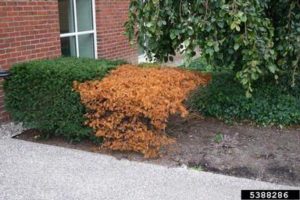 Phytophthora Root Rot:
Phytophthora Root Rot:
Phytophthora Root Rot is an extremely damaging and widespread fungus like organism that will rot away root systems and eventually kill your tree if left untreated. In the worst cases, when left untreated trees can become structurally unsafe and uproot or snap possibly causing property damage and injury.
Symptoms: Suppressed growth, yellow or undersized needles/leaves, dieback, drooping and curling of leaves, leaves turning brown.
Targets: Wide range of plants. The most susceptible include Azalea, rhododendron, dogwood, pieris, yew bushes, deodar cedar, mountain laurel, heather, juniper, Fraser fir, white pine, shortleaf pine, camellia japonica, aucuba.
Learn more about Phytophthora Root Rot
Canker Diseases:
Canker Diseases are caused by fungi that commonly enter the tree through wounds in the bark or branch stubs. Improper pruning can increase your risk of cankers.
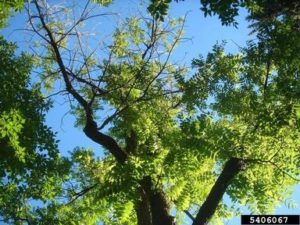 Thousands Canker Disease:
Thousands Canker Disease:
Originally confined to the western parts of the United States, Thousands Canker Diseases, made it to Fairfax County in 2012. The tree fungus, Geosmithia morbida, is spread by the Walnut Twig Beetle. These fungi develop cankers under the bark so cankers will not be visible.
Symptoms: Thinning canopy, discolored leaves, small leaves, individual branch dieback.
Targets: Black Walnuts but all species of walnuts may also be susceptible.
Learn more about Thousands Canker Disease
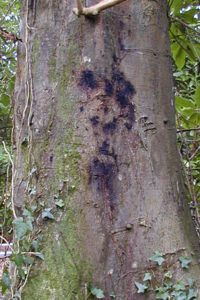 Phytophtoria Bleeding Cankers:
Phytophtoria Bleeding Cankers:
Caused by various species of the Phytophtoria fungi, bleeding cankers are wet looking, oozing areas on the trunk of ornamental and shade trees. These cankers impact the vascular system of the tree, inhibiting important energy transfers.
Symptoms: Reddish-brown fluid oozing from a crack in the bark, above the infected area, foliage may be pale and sparse and branch dieback may start to occur, and a strong alcohol, fermenting smell that attracts insects to the infected areas of the tree.
Targets: Most ornamental and shade trees; however, beech, maple, and oak tend to be highly susceptible.
Learn more about Phytophtoria Bleeding Cankers
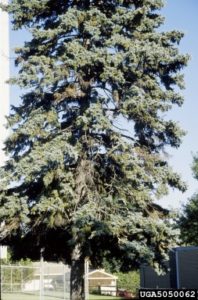 Cytospora Canker:
Cytospora Canker:
Also known as Leucostoma canker, this tree fungus is one of the most damaging diseases of spruces. This fungus grows throughout the inner bark causing the portion of the tree behind the canker to die.
Symptoms: Death of branches starting at the base of the tree moving upward. Cankers aren’t very noticeable, with little to no bark deformation. Needles on infected branches turn grayish and brown.
Targets: Colorado Blue Spruce (and it’s varieties), Norway spruce, koster’s blue spruce, white spruce, Douglas fire, and other spruces.
Learn more about Cytospora Canker
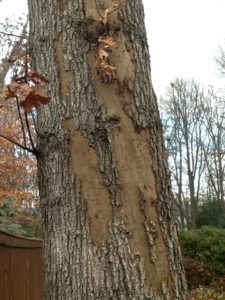 Hypoxylon Canker:
Hypoxylon Canker:
This tree fungus negatively affects growth and can lead to the death of the tree. This fungus is typically a secondary invader; meaning that it usually does not infect healthy hardwoods but targets stressed or injured trees.
Symptoms: At first the cankers show up as light brown or tan and look dry and dusty. Within a few weeks they will turn silvery gray with scattered black spots.
Targets: Hardwoods but has three primary species. Hypoxylon atropunctatum found on Oaks, Hypoxylon mammatum found on Aspen, and Hypoxylon tinctor found on Sycamores.
Learn more about Hypoxylon Canker
Foliar Diseases:
Foliar diseases are very common and caused by fungi that attack the leaves of the tree or shrub.
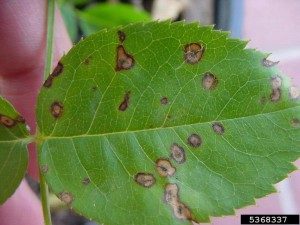 Cercospora Leaf Spot:
Cercospora Leaf Spot:
The tree fungus begins as a small spot on the leaves. As the disease progresses more spots appear until the leaf ceases to function as the site of the tree’s food production process and falls off of the tree.
Symptoms: Round leaf spots (may have purple or dark brown borders), tiny black flecks (fungal spores) in the center of the spots.
Targets: Wide range of ornamentals, shade trees, and plants. Our Arborists report that White Oaks are especially susceptible in our area.
Learn more about Cercospora Leaf Spot
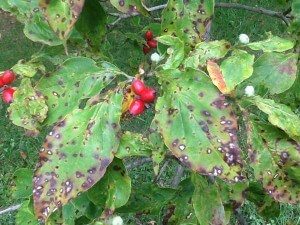 Anthracnose:
Anthracnose:
Anthracnose is a tree fungus that is active in the spring when the weather is wet and cool. Overwintering in fallen leaves, this fungus will continue to infect your tree year after year if not treated. Multiple infestations can leave trees stressed and susceptible to secondary invaders.
Symptoms: tan to brown leaf spots which many have purple rings around them, wilting, defoliation, dieback, leaf blotches.
Targets: Dogwoods, Ash, Oak, Sycamore, Birch, Walnut, Tulip, Hickory, and Maple
Learn more about Antracnose
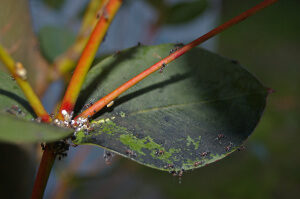 Sooty Mold:
Sooty Mold:
Sooty mold is a fungus that grows on top of honeydew (the excrement of plant-sucking insects) and coats the leaves to the point where they can no longer absorb sunlight. This interrupts photosynthesis and the tree will not be able to produce the nutrients they need for survival. If your trees and shrubs are turning black you most likely have a sooty mold problem caused by an insect infestation.
Targets: Typically seen on rose, ash, oak, elm, maples, willow, and fruit trees.
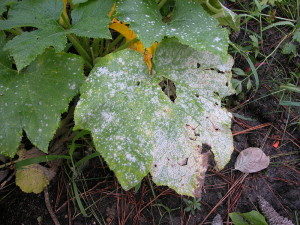 Powdery Mildew:
Powdery Mildew:
Powdery Mildew is a tree fungus that coats leaves blocking the process of photosynthesis. Every year trees and shrubs rely on photosynthesis to create food for new leaf growth. When this process is interrupted by powdery mildew the food reserves aren’t replenished and the tree/shrub’s growth will be stunted which can affect overall health. The stress caused by Powdery Mildew also makes the tree more susceptible to other diseases and insect infestations.
Symptoms: Powdery mildew is characterized by spots or patches of white to grayish, talcum-powder like growth on the upper side of leaves.
Targets: A wide range of plants but Lilacs, Peonies, Dogwoods, or Crape Myrtles are especially susceptible in this area.
Learn more about Powdery Mildew
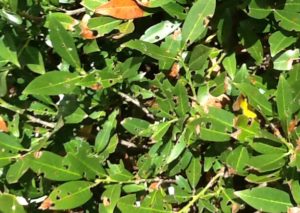 Shot Hole Fungus:
Shot Hole Fungus:
This tree fungus is commonly mistaken for insect damage because of the BB-sized holes it leaves. This fungus will stress your plants and should be treated to keep secondary invaders away.
Symptoms: Brown or reddish-brown leaf spots, holes in leaves where the leaf spots used to be, yellow leaves dropping in mid-summer.
Targets: Cherries and Cherry Laurels
Wilt Diseases:
Wilt diseases are caused by fungi that invade a tree’s vascular system. With the vascular system compromised the tree cannot transport water and nutrients throughout itself.
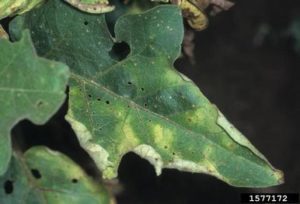 Verticillium Wilt:
Verticillium Wilt:
Verticillium Wilt is caused by the soil-borne fungi Verticillium albo-atrum and Verticillium dahliae. The tree fungus invades through the roots then spreads through the plant’s vascular system. Once the Xylem, the tree’s water transportation system, is infected it becomes clogged and water can no longer reach the tree’s leaves. Verticillium is common and affects several hundred species of trees and shrubs.
Symptoms: Leaf curling, drying, small yellow foliage, leaf scorch, and slow growth. Often times the symptoms are seen on one side or section.
Targets: Ash, Azalea, Cherry, Certain species of Dogwood or Linden, Locust, Magnolia, Maple, Oak, and Redbud.
Learn more about Verticillium Wilt
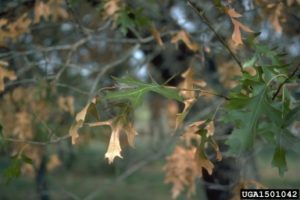 Oak Wilt:
Oak Wilt:
Oak wilt is a disease that targets oak trees and is caused by the fungus Ceratocystis fagacearum. Spread through insects and connections between roots, there are no resistant or immune oak species. This illness was first found in 1944 in Wisconsin but has now spread to 21 states. Oak wilt is devastating and can kill rapidly within a single season.
Symptoms: Leaf discoloration, wilt, defoliation, and ultimately the death of the tree from the top down.
Targets: All species of oaks. Red oaks succumb to the diseases faster than white oaks.
Learn more about Oak Wilt
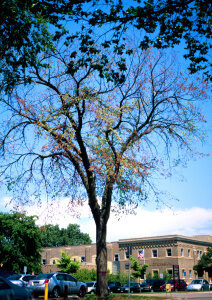 Dutch Elm Disease:
Dutch Elm Disease:
Dutch Elm disease, one of the most destructive shade tree diseases in North America, is caused by a fungus spread by the elm bark beetle. First reported in the U.S in 1928, the disease is believed to have been brought over from the Netherlands in a shipment of logs. Out of the 77 million elms in North America in 1930, over 75% had been lost by 1989. To this day, the Elm population across the United States is still battling this toxic disease.
Symptoms: Dutch Elm Disease causes leaf wilting, curling and yellowing of leaves, leaf drop, and will kill your tree.
Targets: Elms
Learn More About Dutch Elm Disease
Didn’t Find What You Were Looking For? Check out our Diseases and Bug indexes.
Diseases
Bugs
Worried your tree is infected with one of these fungi? Use our online booking system or call 703.573.3029 to schedule a consultation with an arborist to diagnose your tree fungus.
